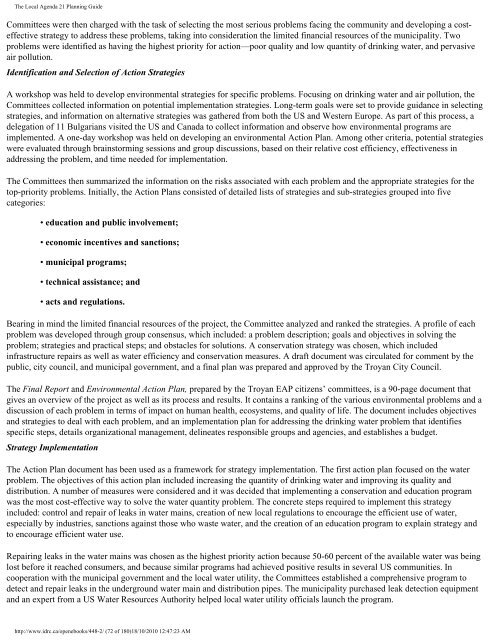The Local Agenda 21 Planning Guide - Democrats Against UN ...
The Local Agenda 21 Planning Guide - Democrats Against UN ...
The Local Agenda 21 Planning Guide - Democrats Against UN ...
Create successful ePaper yourself
Turn your PDF publications into a flip-book with our unique Google optimized e-Paper software.
<strong>The</strong> <strong>Local</strong> <strong>Agenda</strong> <strong>21</strong> <strong>Planning</strong> <strong>Guide</strong><br />
Committees were then charged with the task of selecting the most serious problems facing the community and developing a costeffective<br />
strategy to address these problems, taking into consideration the limited financial resources of the municipality. Two<br />
problems were identified as having the highest priority for action—poor quality and low quantity of drinking water, and pervasive<br />
air pollution.<br />
Identification and Selection of Action Strategies<br />
A workshop was held to develop environmental strategies for specific problems. Focusing on drinking water and air pollution, the<br />
Committees collected information on potential implementation strategies. Long-term goals were set to provide guidance in selecting<br />
strategies, and information on alternative strategies was gathered from both the US and Western Europe. As part of this process, a<br />
delegation of 11 Bulgarians visited the US and Canada to collect information and observe how environmental programs are<br />
implemented. A one-day workshop was held on developing an environmental Action Plan. Among other criteria, potential strategies<br />
were evaluated through brainstorming sessions and group discussions, based on their relative cost efficiency, effectiveness in<br />
addressing the problem, and time needed for implementation.<br />
<strong>The</strong> Committees then summarized the information on the risks associated with each problem and the appropriate strategies for the<br />
top-priority problems. Initially, the Action Plans consisted of detailed lists of strategies and sub-strategies grouped into five<br />
categories:<br />
• education and public involvement;<br />
• economic incentives and sanctions;<br />
• municipal programs;<br />
• technical assistance; and<br />
• acts and regulations.<br />
Bearing in mind the limited financial resources of the project, the Committee analyzed and ranked the strategies. A profile of each<br />
problem was developed through group consensus, which included: a problem description; goals and objectives in solving the<br />
problem; strategies and practical steps; and obstacles for solutions. A conservation strategy was chosen, which included<br />
infrastructure repairs as well as water efficiency and conservation measures. A draft document was circulated for comment by the<br />
public, city council, and municipal government, and a final plan was prepared and approved by the Troyan City Council.<br />
<strong>The</strong> Final Report and Environmental Action Plan, prepared by the Troyan EAP citizens’ committees, is a 90-page document that<br />
gives an overview of the project as well as its process and results. It contains a ranking of the various environmental problems and a<br />
discussion of each problem in terms of impact on human health, ecosystems, and quality of life. <strong>The</strong> document includes objectives<br />
and strategies to deal with each problem, and an implementation plan for addressing the drinking water problem that identifies<br />
specific steps, details organizational management, delineates responsible groups and agencies, and establishes a budget.<br />
Strategy Implementation<br />
<strong>The</strong> Action Plan document has been used as a framework for strategy implementation. <strong>The</strong> first action plan focused on the water<br />
problem. <strong>The</strong> objectives of this action plan included increasing the quantity of drinking water and improving its quality and<br />
distribution. A number of measures were considered and it was decided that implementing a conservation and education program<br />
was the most cost-effective way to solve the water quantity problem. <strong>The</strong> concrete steps required to implement this strategy<br />
included: control and repair of leaks in water mains, creation of new local regulations to encourage the efficient use of water,<br />
especially by industries, sanctions against those who waste water, and the creation of an education program to explain strategy and<br />
to encourage efficient water use.<br />
Repairing leaks in the water mains was chosen as the highest priority action because 50-60 percent of the available water was being<br />
lost before it reached consumers, and because similar programs had achieved positive results in several US communities. In<br />
cooperation with the municipal government and the local water utility, the Committees established a comprehensive program to<br />
detect and repair leaks in the underground water main and distribution pipes. <strong>The</strong> municipality purchased leak detection equipment<br />
and an expert from a US Water Resources Authority helped local water utility officials launch the program.<br />
http://www.idrc.ca/openebooks/448-2/ (72 of 180)18/10/2010 12:47:23 AM










